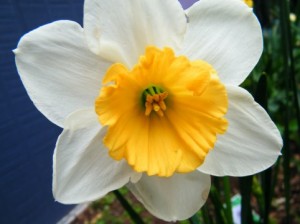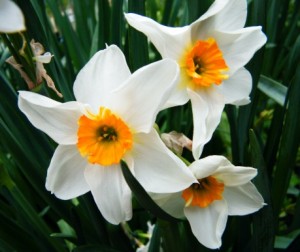Dear Daffnetters,
Heather O’Flynn would like help in identifying her daffodils. Heather lives in Australia and provided the attached photos and purchase information along with the time of year each daffodil blooms.
If you can help Heather, please send her an email at: 
Many Thanks,
Nancy Tackett Martinez, Calif
I have attached two images of the flowers in question. The image titled “Unsure of Name” was purchased in a mixed bag of bulbs from the garden department of a hardware store 15 months ago and it flowered in August/September 2009. The stem is long. The petals are white and the cup is more of an orange rather that a yellow and the trumpet itself is more flat than long. A very pretty bloom. The image titled “No Idea” was in the same bag as the one above and it flowered in September. At first I thought this flower was a jonquil because the cup was so small but it really looks like a mini daffodil. It has narrow white petals and an orange and yellow variegated cup on a long stem. Although this is beside the point, the bag of mixed bulbs I bought were labelled jonquils and considering “Unsure of Name” is clearly not a jonquil it is surprising that I didn’t end up with a crop of onions. Heather



My understanding is that such packages of mixed bulbs are often discarded mixed seedlings, so even if they resemble some known cultivar, there is no assurance that they are in fact that named variety. This makes naming of unknown blooms a risky business. This is one of the reasons I support the practice of allowing “unknown” entries in shows. Across the US, experienced daffodillians make up names for these blooms, usually brought to shows by less experienced exhibitors. I’ve never understood why it makes sense to display a bloom as an impostor for a truly named variety, but it is unacceptable to employ humble honesty, and label it “unknown.” Melissa
Some shows do have a class for “unknown” or “un-named” daffodils. They just aren’t eligible for ADS awards. One show calls the class “Don’t know the name but we love them just the same.” If anyone thinks they know the name, they write it on after judging, or tell the exhibitor.
Mary Lou
“The Lady is not for turning” !! A Famous quote!
Hello Melissa, I know that daffodil breeders send out packs of discarded seedlings, and I shall be quick with the name of “unnamed seedling” in the future. However, when you get mixed bulbs at the garden center they ought to be from a commercial enterprise- my experience is that these are mostly “Ice Follies” and I do not know whom is distributing them, but if something nice turns up, I wonder if it is not more likely that an established trade cultivar is what was provided.
John Beck
This does not solve the problem, as it provides only partial admission of the legitimacy of the bloom. There remains a powerful incentive for helpful, well-meaning & respected exhibitors to provide a name for the bloom so that it can be afforded full status. Then we are back in the soup of conjecture and probable inaccuracy. Only when “unknown” is recognized with full status to win any award will the incentive for made-up names cease to result in inaccurate naming. Melissa